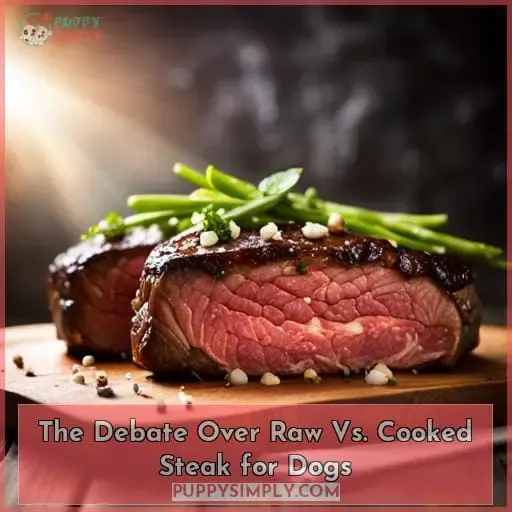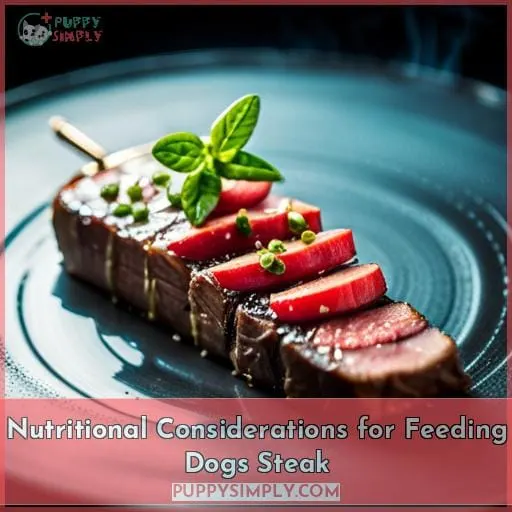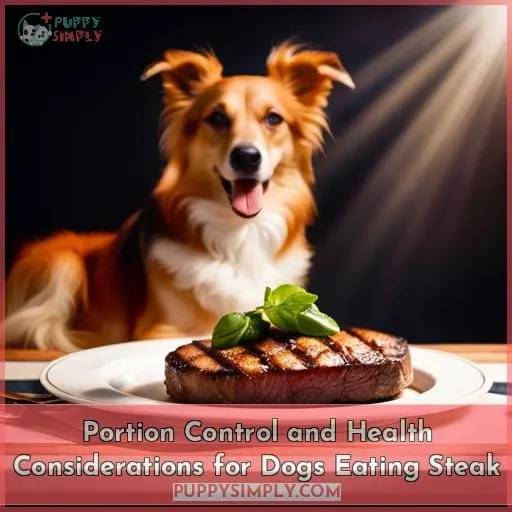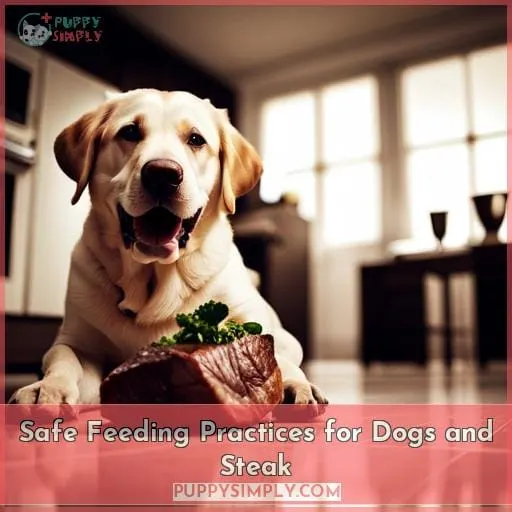This site is supported by our readers. We may earn a commission, at no cost to you, if you purchase through links.
 So, your pup’s been eyeing up your steak for a while now, and you just can’t help but wonder: Can dogs eat steak? The answer is both yes and no. As omnivores with powerful jaws designed to tackle tough meats like beef or pork, sure – it’s natural for them to crave the taste of meat.
So, your pup’s been eyeing up your steak for a while now, and you just can’t help but wonder: Can dogs eat steak? The answer is both yes and no. As omnivores with powerful jaws designed to tackle tough meats like beef or pork, sure – it’s natural for them to crave the taste of meat.
But before you start serving up steaks from the dinner table every night – take heed! Even though most types of cooked steak are not toxic to our furry friends – there are some serious considerations when feeding them this type of protein-rich treat.
Table Of Contents
- Key Takeaways
- Is Steak Safe for Dogs?
- The Debate Over Raw Vs. Cooked Steak for Dogs
- Nutritional Considerations for Feeding Dogs Steak
- Portion Control and Health Considerations for Dogs Eating Steak
- Safe Feeding Practices for Dogs and Steak
- Can Dogs Eat Steak Fat and Trimmings?
- Can Dogs Eat Steak Bones?
- Conclusion
Key Takeaways
- Dogs can consume steak, but precautions are essential.
- Lean cuts like top sirloin or bottom round are safer options.
- Cooking eliminates potential bacterial hazards.
- Consult a veterinarian before introducing steak.
Is Steak Safe for Dogs?
Considering the nutritional and safety concerns, it’s important to make an informed decision when considering steak for your pup. Proper cooking methods are essential; grilling is generally safer than frying in oil or butter.
Additionally, lean cuts like top sirloin or bottom round should be used with moderation. If giving regular steak treats, adjust kibble portions accordingly to avoid obesity due to overeating.
Carefully consider potential allergic reactions as well. If any occur after eating steak, then switch up proteins and opt for alternative meat options instead, such as fish or eggs, which provide similar nutrition but lower fat content.
Homemade dog food containing cooked beef may also serve as a balanced diet option supplemented by digestive enzymes specifically designed for dogs to boost nutrient absorption from their meals!
Ultimately, do your research before feeding your pup any type of meat. Small amounts of cooked beef can benefit them nutritionally; however, ensure you’re meeting all canine dietary requirements safely first!
The Debate Over Raw Vs. Cooked Steak for Dogs
The debate over raw versus cooked steak for dogs has been a longstanding one. On the one hand, raw meat diets may be linked to bacterial risks such as salmonella and contamination, prompting the FDA to issue warnings against them.
On the other hand, cooking steak is safer and provides essential nutrients that are not available in an all-meat diet alone. Therefore, it’s important when considering this dilemma to prioritize dog safety and health above all else.
The Risks of Raw Meat Diet for Dogs
Although raw meat may seem like a tasty treat for your furry friend, there are several potential risks associated with this diet. Salmonella contamination is an ever-present concern when feeding dogs raw steak.
The FDA has issued warnings against the consumption of uncooked animal products due to bacterial content and disease risk.
Raw meat diets have been met with controversy in recent years, as experts express concerns over long-term health effects from inadequate nutrition or bacteria exposure. Additionally, maintaining nutritional balance is difficult on a strictly carnivorous diet since it lacks vital vitamins and minerals found in fruits and vegetables that canines require for optimal health outcomes.
To ensure your pup’s safety while still enjoying delicious steak treats, consider cooking them properly before serving – just make sure not to add any additional seasonings!
The Benefits of Cooking Steak for Dogs
Cooking steak for your pup provides essential proteins and fatty acids, while protecting them from the risks of raw meat. Lean cuts such as top sirloin or bottom round are recommended, with proper cooking techniques to ensure safe eating.
Veterinary-approved dietary guidelines suggest limiting fat content when preparing meals and avoiding seasoning altogether.
Low-fat cuts of steak offer additional health benefits that can help maintain a balanced diet in accordance with their canine ancestors’ natural meat-based diet habits. Steak should be cooked separately without extra seasonings or fats for safety’s sake.
Nutritional Considerations for Feeding Dogs Steak
Steak may be included in your dog’s diet with veterinary approval, and it is a nutritious source of protein, iron, and omega-6 fatty acids. Prior to adding steak to their diet, however, it is important to consult a veterinarian for specific dietary recommendations.
Protein, Iron, and Omega-6 Fatty Acids in Steak
Steak is packed with protein, iron, and beneficial omega-6 fatty acids that can help keep your pup healthy. When added to a balanced diet in moderation, steak proves to be an excellent source of dietary iron for dogs.
Omega 6 intake also helps maintain healthful skin and coat while providing energy boosts from the high levels of protein found in lean cuts like top sirloin or bottom round. A protein-rich diet is essential for canine growth and development but should always be monitored carefully as excess consumption may lead to obesity or other chronic diseases linked with kibble diets.
Steak cooked without seasoning offers up these nutritional benefits safely when portioned appropriately along with proper food handling techniques such as thawing meat correctly before feeding it cooled into small pieces suitable for dogs’ digestive systems.
Consulting a Vet for Dietary Recommendations
It’s important to consult a vet before adding steak to your pet’s diet, as the American Veterinary Medical Association recommends that owners provide their pets with balanced nutrition. A veterinary consultation will determine if steak is safe and suitable for your dog based on breed, age, activity level, and health status.
Furthermore, customized diet planning can be created by vets to account for any special dietary needs or allergies your pup may have. Regular check-ups are also important when feeding dogs steak so that they can monitor nutrient deficiencies or allergic reactions over time due to changes in food consumption habits.
Consulting a veterinarian prior to introducing new foods into a dog’s diet ensures the safety and optimal health of the animal while helping them enjoy meals without worrying about potential risks associated with certain ingredients, like those found in cooked steaks!
Portion Control and Health Considerations for Dogs Eating Steak
You may be considering giving your dog steak as an occasional treat, but it’s important to take into account portion control and health considerations. Excessive consumption of high-fat steaks can lead to obesity in dogs, so treats should be balanced with regular kibble portions.
Furthermore, a diet consisting solely of meats lacks essential nutrients necessary for optimal canine health; variety is key when feeding dogs steak.
Avoiding Excess Consumption and Obesity
When it comes to portion control, you must ensure your furry friend doesn’t overindulge; otherwise, obesity and other health risks may follow. To avoid excess consumption of steak for dogs, consider healthy treat alternatives such as fruits or veggies instead.
Additionally, maintain a consistent exercise routine and monitor their weight consistently to prevent dog obesity. For optimal nutritional balance when feeding steak to dogs, limit the serving size of lean cuts like top sirloin or bottom round.
Finally, remember that an all-meat diet lacks essential nutrients, so providing variety in meals is important for overall wellbeing!
Balancing Steak Treats With Regular Kibble Portions
To ensure your pup stays healthy, you should adjust their kibble portions when adding steak treats to their diet. For instance, if your dog usually eats one cup of kibble per day, try cutting back to half a cup on days they get a steak treat.
A dietary balance is essential for avoiding obesity and upset stomachs caused by excess consumption or ingredients not suitable for dogs in large amounts such as bones or fat trimming. Consult with an expert about the frequency of steaks given alongside regular food and nutritional requirements specific to each breed.
Portion control helps maintain optimal health while still providing occasional indulgences like steak!
Safe Feeding Practices for Dogs and Steak
When feeding steak to your dog, it is essential to take proper precautions. Avoid high-fat content such as butter and oil, in addition to toxic ingredients like salt and garlic. It’s important that the steak is prepared correctly for dogs; cook it separately without seasoning and chop it into small pieces after cooling down completely.
Avoiding High-Fat Content and Toxic Ingredients
Be sure to trim excess fat before cooking steak for your pup and always avoid toxic ingredients. High-fat content can lead to obesity, so use lean cuts like top sirloin or bottom round when possible. Don’t add butter or oil as these’re sources of unhealthy fats that could be dangerous for your dog’s health in the long run.
Avoid seasoning with salt, pepper, garlic, or other spices as they may contain toxins that could make them sick if ingested in large quantities.
With careful attention given towards ingredient safety and proper cooking techniques, you’ll have peace of mind knowing that you’re providing a safe yet tasty snack time treat every time!
Proper Preparation and Cooking of Steak for Dogs
For optimal safety, cook steak for your pup thoroughly and without additional seasonings or oil. A study conducted by the FDA found that a raw meat diet could increase the risk of foodborne illness in dogs up to 70 times more than cooked diets.
Proper preparation is essential. Thawing precautions must be taken, and seasoning avoidance is key. Cook the steak until it reaches an internal temperature of at least 160 degrees Fahrenheit to kill any bacteria present in the meat before feeding it to your dog.
Supervise consumption if giving plain steak bones to your pet. This is important to prevent them from splintering when chewed on, as it can lead to injuries or choking hazards. Additionally, trim off excess fat from grilled steaks for added safety measures.
Keep these simple but necessary steps in mind while preparing steak for dogs. Following them will ensure that both their nutritional needs are met and all important safety precautions are followed.
Can Dogs Eat Steak Fat and Trimmings?
It’s important to remove excess fat trimmings when feeding steak to your pup, as consumption of too much fat can be dangerous. Dogs’ digestive systems aren’t designed for digesting large amounts of fat, and it may lead to health conditions such as pancreatitis.
When using trimmings safely, moderation is key. Start with a tiny portion and monitor how they react before increasing the amount. Additionally, avoid adding garlic juice or other seasoning that could cause harm when ingested by dogs.
When giving steak in any form, there are potential risks. However, preparing it properly reduces these chances significantly. Choose lean cuts like top sirloin or bottom round, which have less marbling (fat content).
Lastly, if you’re concerned about their intake, consider some healthy alternatives like boiled vegetables added into their meals occasionally instead!
Can Dogs Eat Steak Bones?
Supervise your pup while they enjoy steak bones, as these can splinter. Wolves’ ancestors may have eaten raw steaks with the bone, however, it is not safe for modern-day dogs to do so. Dogs should only consume cooked steak in small portions on occasion and never a whole steak or large quantities of fat trimmings.
Table 1 outlines potential risks associated with giving dogs bones from cooked steaks:
| Risks | Treats | Dental Health | Choking Hazard |
|---|---|---|---|
| Splintering | Raw Steak for Dogs | Yes | |
| Alternative Treats | No | — | — |
A dog’s balanced diet must include more than just meat; vegetables and fruits are essential too! Cooked steaks should be served at medium temperature to ensure safety before feeding it to your pup; avoid seasoning as this can harm them if ingested in excess amounts.
An alternative treat could include kibble that has been linked to chronic diseases but its ingredients vary widely which makes portion control important! If you choose to give your pet cooked steak bones make sure they’re supervised closely due to their risk of splintering – choking hazards are also possible and dental health maintenance is key!
Conclusion
Overall, when it comes to can dogs eat steak, the answer is yes, but only with proper precautions and safety considerations. To ensure canine health, it’s essential to consult your vet and follow the recommended dietary guidelines.
Lean cuts of steak, such as top sirloin and bottom round, should be cooked thoroughly and served in moderation. Remember to keep the fat content low and the portions small, as overindulging can lead to obesity.
As a final note, steer clear of steak bones as they can splinter and cause choking.













